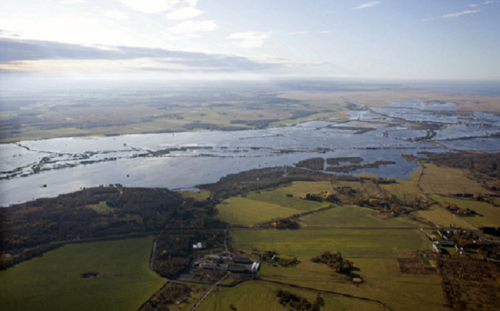Case Study
Spawning area for fish with a water regulator in Matsalu, Estonia
Contact name
Kaja Lotman
Institution name
National Park Matsalu
Region & country
Estonia
Summary
Less water in the spring caused the lagoon in the Estonian Matsalu National Park to disappear. To solve this, an ancient road was transformed into a dam with water regulators. This construction has many benefits for biodiversity, and human landscape appreciation.

Background of the project
A large lagoon in Matsalu National Park is a landmark for the area and an important nursery area for pike. However, because of recent years with less snow in the winter, there is less water in the lagoon in the spring as well. This drastically changes the landscape. There is less space for the fish to inhabit. A 200-year-old road that was not used anymore was passing through the water between the lagoon and the sea.
Next to the fish, cows, birds, and amphibians were also affected by the changing water levels. Because of the relatively flat area, meadows flood quickly. Cows need enough dry space to be able to graze, and wading birds need the meadows to make their nest in. At the same time, amphibians such as the Natterjack toad thrive in the moist areas. Apart from this, the flooded landscape attracts visitors and boosts tourism.
Solution and actions taken
The old road that divided the sea and the lagoon was made into a waterproof dam with water regulators. This way, the pike have enough room to grow to an adequate size, and when they are big enough, the water regulators will be opened. The fish go to the sea, and the meadows clear up. This will give room for the cow to graze and the birds to settle. The person in charge of opening the regulator monitors the needs of the different species.
Last year, the dam was rebuilt. This was done by using plastic to secure the dam in place. At first, there were ideas to make an artificial lake to make the area deeper. In the end they decided to not go with this idea, and keep the natural lagoon, as this would benefit the local flora and fauna, in particular the birds and amphibians. Also, an idea was to build a concrete dam but, finally, the old road was used. This way, cultural heritage is restored and used in a meaningful way.
Other institutions or parties involved
The public and the local municipality were in favour of the idea. They cherished the landscape as it was before and valued the increase in tourism. The fishermen involved were happy with the increased number of pike. They proposed a seasonal no-take zone outside of the lagoon to allow the pike to grow to mature sizes.
Discussions were held with landowners, who opposed at first because of the necessary documentation. They agreed when this work was taken over by the park managers.
Results
The dam has been built. They are waiting for the next spring, to see how many spikes will pass the gates. An advantage of the water regulator is that the monitoring process will be much more precise than before.
Challenges
One of the main difficulties that the area is dealing with is the use of plastics during construction, which was put on a layer of clay to secure the dam. They are currently researching the impact of microplastic on the environment. They are also investigating whether plants can grow on clay to take over the role of the plastic, however, this will take some time as they want natural regeneration of plants and not use exotics species.
Lessons learned
In the end, the situation was not just positive for the fish, but had many biodiversity and cultural benefits. When designing a plan, it is important to consider all other affected factors as well. Another main lesson learned is that it is preferable to use natural and local solutions instead of man-made. This will have as little as possible negative impact on the surroundings.
Contact name
Kaja Lotman
Institution name
National Park Matsalu
Website(s)
